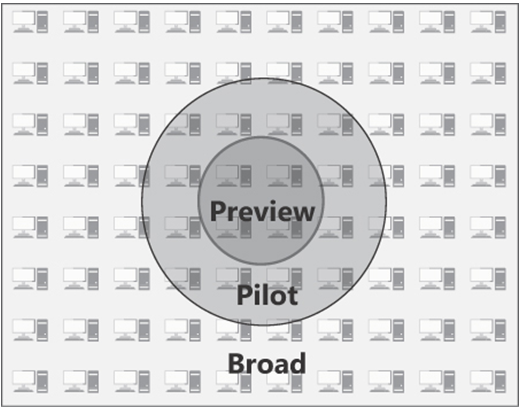Windows-as-a-Service servicing channels-Describe Microsoft 365 apps and services
Servicing channels are options that administrators can select to specify when their Windows clients should receive updates. Microsoft offers three servicing channels in Windows-as-a-Service, as follows:
- General Availability Channel By default, Windows-as-a-Service client installations use the General Availability Channel, which applies all updates as soon as Microsoft releases them. Therefore, the clients receive feature updates twice annually and quality updates monthly.
- Windows Insider Channel For users or organizations that want early access to updates for compatibility testing and the ability to provide feedback to Microsoft, the Windows Insider channel releases all updates before they are made available to the General Availability Channel.
- Long Term Servicing Channel For devices with specialized functions in which continuity is essential, such as medical equipment, point-of-sale systems, and kiosks, there is the Long Term Servicing Channel (LTSC), which receives feature updates only every two to three years. LTSC systems still receive quality updates monthly.
The General Availability feature update cycle begins with a development phase in which the update is first run by Microsoft engineers and then by a larger group of Microsoft internal users for six months, a process that Microsoft calls “dogfooding.” Then, Microsoft releases the feature update to the Windows Insider program members for testing and feedback. Finally, the update goes into general release, which typically consists of a pilot or test deployment in a large enterprise, followed by a general production deployment to all workstations, as shown in Figure 2-58.

FIGURE 2-58 Phases of a Windows 10 feature update release
Windows deployment rings
In a responsible enterprise, deploying an operating system—or any software—is a rigorously planned process executed in phases. One of the common plans used in Windows deployments calls for three phases, which Microsoft refers to as rings, as shown in Figure 2-59.

FIGURE 2-59 Windows deployment rings
The rings represent the growing size of the deployment groups. While the names assigned to the rings might differ, the phases of the deployment are often as follows:
- Preview A small group that receives the software before the general release for basic functionality and feature testing, such as Windows Insider users.
- Pilot A larger, but still relatively small, group that receives the software immediately upon general release to validate its functionality on a larger variety of devices.
- Broad Sometime after the general release, barring problems experienced by the previous groups, the software goes into wide release to the entire organization.
